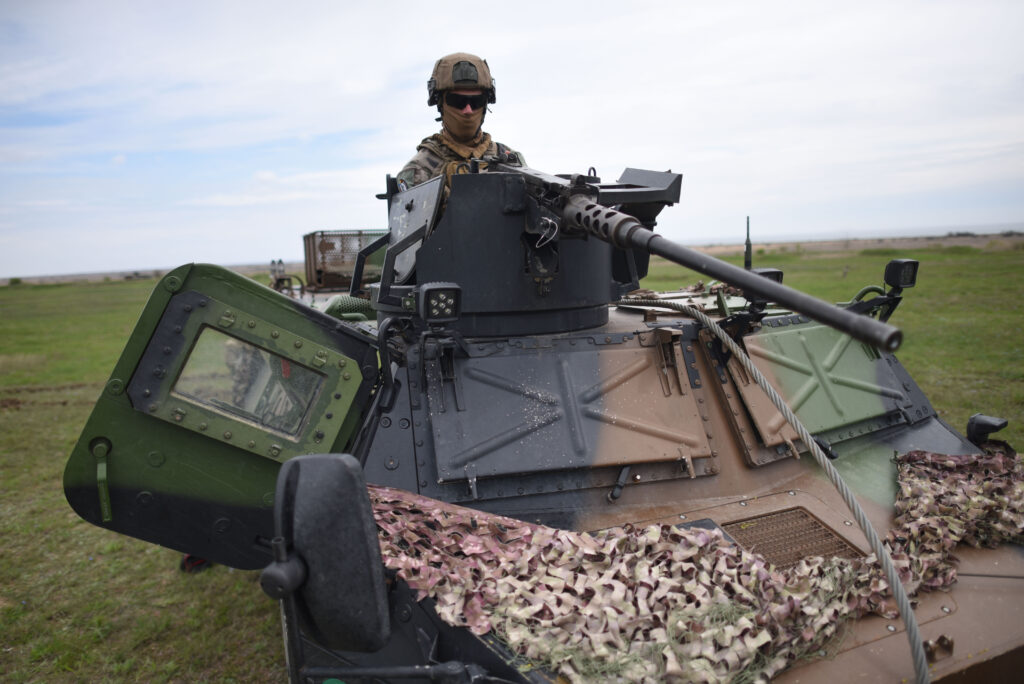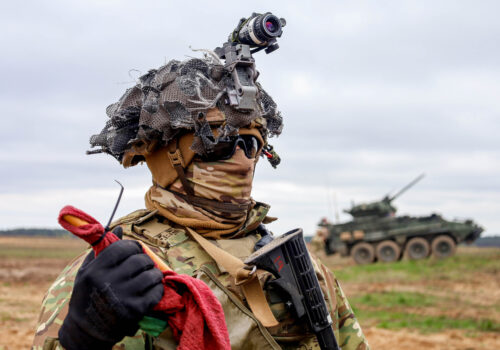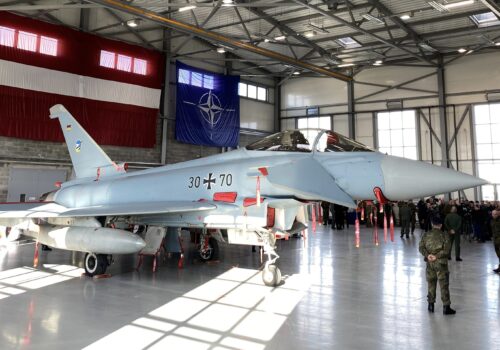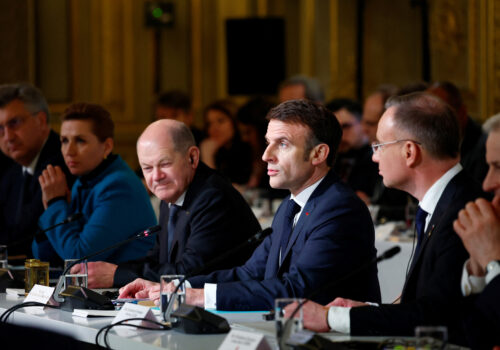Since Russia’s full-scale invasion of Ukraine in February of 2022, NATO’s credibility is most at stake on Europe’s eastern flank. Reinforcing NATO members in this region through increased military presence and bolstering defense and deterrence posture are the top priorities for most political and military leaders in Europe.
In April, a team from the Atlantic Council’s Europe Center took a research trip to Romania and Estonia, alongside the French military and saw firsthand how Western and Eastern European countries, along with US forces, are working together to adapt to the Russian threat just miles way.
We found that European commitments to the eastern flank are substantial and geared for the long term. However, using the force structure they have today to address the needs of conventional deterrence will require new adaptations. Even so, the advances in cooperation between Western and Eastern European troops on the eastern flank in the past two years represent tangible, significant European contributions to the Alliance that should move the debate around burden sharing past a singular focus on defense spending metrics.
A more united front
As Moscow reconstitutes its forces, there is a real possibility that Russia will test European and NATO resolve in the Alliance’s east. Each of those countries has specific geographic factors and threats, which the “tailored” approach to the eight battlegroups spread throughout the region are designed to defend. One of the major challenges is convincing Russia that the Alliance can operate as a united front from the Baltic Sea to the Black Sea. The accession of Sweden and Finland better allows for such unity. Broadly speaking, however, the region is still in the process of becoming integrated militarily, and there is still competition for attention due to resource limitations and a lack of harmonization due to national specificities.
Located on the Black Sea and bordering Ukraine, Romania is but a few hundred kilometers from the war’s frontlines. The Russian military is operating in such close proximity to the country that Russian drones have repeatedly entered Romanian airspace and there have even been incidents of Russian drones landing in Romanian territory, most recently on Brăila Island in March 2024.
Looking north, Estonia sees itself in a critical window to improve its defensive positions while the Russian units normally garrisoned across its border are deployed to Ukraine, and before those units reconstitute, now battle-hardened from years of full-scale war. In the event Russia decides to seriously test NATO’s resolve, Estonia could be the first line of incursion. This is why at the 2023 Vilnius summit, NATO adopted new plans to “defend every inch” of the Alliance’s territory, including an enhanced presence in the Baltics meant to prevent an incursion in the region. This marked a shift away from a posture that was more focused on regaining territory that would likely be occupied in the initial stages of an invasion. It’s also why, beyond national resolve, the enduring presence of US, British, and French boots on the ground is crucial for Estonia: Each of those three nations has nuclear capabilities to back conventional forces, affecting Russia’s calculus.
Western Europe’s investment in the eastern flank is here to stay
After Russia’s invasion, Western Europeans turned their attention toward NATO’s eastern flank. For France, which is present in both countries we visited, the war in Ukraine is the first major test of the country’s concrete commitment to the Alliance since it reintegrated into NATO’s military command structure in 2009.
However, military ties between Western and Eastern Europe also rest on the strengthening of bilateral relationships among NATO members, especially between host countries and the framework nations for NATO’s multinational battalions—for instance, Britain is the framework nation in Estonia, Germany in Lithuania, and France in Romania. All have strengthened mutual ties since the start of the war in Ukraine. For example, France’s strategic partnership with Romania has deepened and intensified since it committed to becoming a framework nation in Romania in February 2022. These exchanges at the political and military level played a role in the growing convergence of views between the two countries on the nature of the threat Russia poses to the rest of Europe beyond Ukraine.
In the French-led Mission Aigle, European troops train and plan together in Cincu, Romania, ready to respond to potential threats on NATO’s eastern flank. Although US troops are present in other parts of Romania, they are not present in Cincu, giving Europeans a chance to build up their own efforts independent of US contributions. French troops rotate on a four-month basis, which allows a high number of soldiers to cycle through. The plan is to build Cincu into a brigade-sized (around four thousand troops) presence by 2025. Within the 117 square kilometers of Cincu, the French, Belgian, and Luxembourgian forces (soon to be joined by a company of Spanish troops) are a model for interoperability and commitment; They represent burden-sharing in action.
These troops are also presented with challenges. For decades, Western armies have been tailored for counterinsurgency warfare, such as in various African theaters and the NATO mission in Afghanistan. They simply aren’t prepared for the “what’s old is new” style of warfare that Russia’s invasion of Ukraine has reintroduced into the modern battlefield. As such, France and its partner nations are studying Russia’s playbook in Ukraine, which includes practicing trench warfare and referencing tactical manuals from World War I to help inform their strategy. One of the French forces’ aims in Romania is to demonstrate to Russia that they are ready to fight. French military leaders are working with their Romanian counterparts to navigate some of the challenges of conducting deterrence and defensive missions in the country, as local laws have not yet evolved to enable effective training due to stringent peacetime rules.
Similar developments are taking place in Estonia. Britain, France, and the United States have all committed forces to Estonia to match and complement Estonian investment in its own defense. The French commitment is built around one company within the British-led NATO battlegroup. Since Russia’s full-scale invasion of Ukraine, Britain has doubled its presence in Estonia. Based on six-month deployments, more than ten thousand British soldiers have already rotated through Tapa, Estonia. The British Army continues to evolve its armored infantry presence in the NATO mission and has committed to have additional postured forces on high alert in the United Kingdom to be able to create a full brigade during a crisis.
Estonian, British, and French leaders recognize that the current arrangements also face challenges. There is a scarcity of some critical enablers in Estonia, with a strong desire to increase intelligence and surveillance capabilities, expand long-range fires, and embed army aviation units in Estonia. The deployment of follow-on forces has yet to be thoroughly tested, although exercises are planned in the coming years to stress test national and NATO military mobility capabilities.
What does this mean for the United States?
The increase of Western European states’ commitment to the eastern flank is not a panacea for enduring capability gaps in Alliance defenses. The United States continues to be the only nation able to supply key enablers at scale sufficient for effective deterrence for the foreseeable future. European land force leaders we spoke to worry that US key enablers based in Europe, such as long-range fires, air defense, and attack aviation, are likely postured to predominantly support US forces under US command. Without additional enablers brought in from the United States or provided by European nations, NATO land forces will be unlikely to train with and, if necessary, conduct combat operations with the full toolbox of capabilities.
To mitigate concerns among allies, the United States should consider increasing integration training opportunities within NATO, as well as battlegroups and associated higher echelons with those key enablers, to familiarize these units with key enabling capabilities while acquisition of long-term permanent solutions progresses. US stakeholders should be involved in national or European Union (EU) initiatives to improve mobility, interoperability, and command-and-control to ensure that proposed solutions benefit all Alliance members. This means investing in the development of EU-NATO cooperation as well as in the European pillar within NATO. Policymakers in Washington need to expand the conversation on burden sharing so that it accurately captures the steps Europeans are taking without the United States within and outside of NATO.
Western European commitments to NATO’s east represent tangible allied contributions to NATO deterrence and defense. Watching French soldiers in Romania practice trench warfare alongside their European counterparts might not seem like a major achievement to decision makers in Washington, but it’s precisely these types of side-by-side, long-term engagements, with soldiers from different countries, that makes the transatlantic partnership. Beyond big-picture questions like capabilities and acquisition and procurement, this kind of cooperation is where, in the event of a crisis, victory will be won.
Léonie Allard is a visiting fellow at the Atlantic Council’s Europe Center, previously serving at the French Ministry of Armed Forces.
Andrew Bernard is a retired US Air Force Colonel and a visiting fellow in the Atlantic Council’s Europe Center.
Rachel Rizzo is a nonresident senior fellow at the Atlantic Council’s Europe Center.
Lisa Homel is an associate director of the Atlantic Council’s Europe Center where she supports the center’s work on France, Germany, the Western Balkans, and Central and Eastern Europe.
Their trip to Romania and Estonia was supported by the French Ministry for Armed Forces.
Further reading
Mon, May 6, 2024
Dispatch from Vilnius: Allies still waiting for the ‘Long Telegram’ from Washington
New Atlanticist By Andrew D’Anieri, Doug Klain
US and European policymakers should learn from the urgency with which frontline nations regard the threat of a Russian invasion.
Wed, Mar 13, 2024
NATO should establish a Baltic Security Initiative at the Washington summit
New Atlanticist By Franklin D. Kramer, Hans Binnendijk
The Baltic nations are justifiably concerned that they could be the next targets of a reconstituted Russian military.
Fri, Mar 1, 2024
Don’t let the ‘boots on the ground’ debate obscure the progress France is making on Ukraine
New Atlanticist By Léonie Allard
Too much focus on the French president’s speculative comments about a potential Western military presence in Ukraine is a distraction from the concrete steps that European leaders made in Paris to support Kyiv.
Image: April 26, 2023 -Capu Midia, Romania: French soldiers take part the NATO exercise Eagle Royal . The NATO drill took place under French supervision, with a a few soldiers from the US, the Netherlands, Romania, and Luxembourg, as a mean to improve coordination for artillery missions. Mehdi Chebil.



